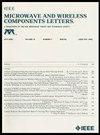用于S波段微波传输的双频带超薄偏振变换器
IF 3.3
2区 工程技术
Q2 ENGINEERING, ELECTRICAL & ELECTRONIC
引用次数: 2
摘要
在这封信中,设计了一种低剖面双频带频率选择表面(FSS)作为卫星通信的偏振器。这种单层FSS具有与金属带相交的曲折开环,表现为双感偏振器。它将频率范围为2.01–2.64 GHz的线性极化(LP)电磁波转换为左旋圆极化(LHCP)电磁波。类似地,3.26–3.68 GHz频率范围内的LP波被转换为右旋圆极化(RHCP)EM波。紧凑型偏振器的晶胞尺寸为$0.75\lambda _{0}\times 0.075\lambda _{0}\ times 0.005\lambda_{0}$,其中$\lambda-{0}$代表最低截止频率下的自由空间波长。本研究探索了所提出的偏振器的结构设计演变,并使用电路模型验证了该结构的频率特性。实验测试了双频带偏振器的模拟性能。在模拟结果和测量结果之间观察到良好的一致性。本文章由计算机程序翻译,如有差异,请以英文原文为准。
Dual-Band Ultrathin Polarization Converter for S-Band Microwave Transmission
In this letter, a low-profile dual-band frequency selective surface (FSS) is designed as a polarizer for satellite communication. This single-layered FSS with a meandered open loop intersected by a metallic strip behaves as a dual sense polarizer. It converts linearly polarized (LP) EM waves of frequency range 2.01–2.64 GHz into left-hand circularly polarized (LHCP) EM waves. Similarly, the LP waves in the frequency range of 3.26–3.68 GHz are converted into right-hand circularly polarized (RHCP) EM waves. The unit cell dimension of the compact polarizer is $0.075\lambda _{0} \times 0.075\lambda _{0} \times 0.005\lambda _{0}$ , where $\lambda _{0}$ stands for free space wavelength at the lowest cut-off frequency. This study explores the structural design evolution of the proposed polarizer and verifies the frequency behavior of the structure using a circuit model. The simulated performance of the dual-band polarizer is experimentally tested. Good concordance is observed between the simulated and measured results.
求助全文
通过发布文献求助,成功后即可免费获取论文全文。
去求助
来源期刊

IEEE Microwave and Wireless Components Letters
工程技术-工程:电子与电气
自引率
13.30%
发文量
376
审稿时长
3.0 months
期刊介绍:
The IEEE Microwave and Wireless Components Letters (MWCL) publishes four-page papers (3 pages of text + up to 1 page of references) that focus on microwave theory, techniques and applications as they relate to components, devices, circuits, biological effects, and systems involving the generation, modulation, demodulation, control, transmission, and detection of microwave signals. This includes scientific, technical, medical and industrial activities. Microwave theory and techniques relates to electromagnetic waves in the frequency range of a few MHz and a THz; other spectral regions and wave types are included within the scope of the MWCL whenever basic microwave theory and techniques can yield useful results. Generally, this occurs in the theory of wave propagation in structures with dimensions comparable to a wavelength, and in the related techniques for analysis and design.
 求助内容:
求助内容: 应助结果提醒方式:
应助结果提醒方式:


